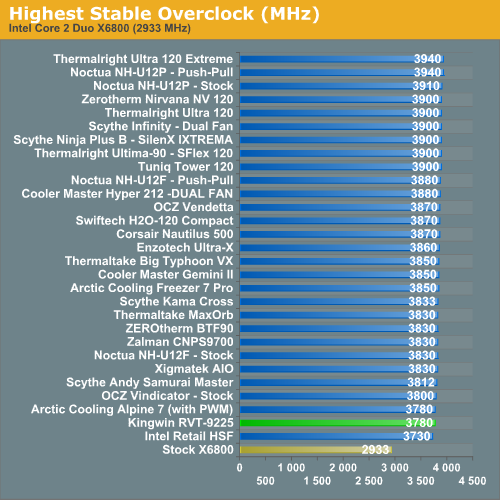Kingwin RVT-9225: Budget priced cooling results in budget performance
by Matt Campbell on July 16, 2008 2:00 AM EST- Posted in
- Cases/Cooling/PSUs
Overclocking
Some users buy aftermarket coolers to quiet down their system, but many are seeking performance gains in the area of overclocking. In the days of shoddy Intel HSFs, a quality aftermarket cooler could equal double-digit percentage gains. As we've mentioned previously, Intel's current incarnation is quite good, but gains can still be significant. Let's see how the RVT-9225 stacks up. Again, the same processor and settings are used for all cooling tests for consistency.

The Kingwin RVT-9225 just barely scrapes a lead over the Intel unit with a maximum stable speed of 3.78GHz. This is disappointing, particularly as the noise level is so much higher than the competing units.
Performance Scaling
Performance scaling is shown below - keep in mind that lower is better in this case. As mentioned the maximum overclocks top out at 3.78GHz, but we file this under "3.83GHz" (rounding up).
 |
Again, we see what seems to be a theme: the RVT-9225 tracks the Intel unit almost exactly. It only ekes out a slight win at 3.33GHz.
Load conditions are a good indicator of cooling performance, and as we've said in the past, a flatter line here is better versus a steep slope (indicating that the cooler cannot effectively handle the load it's being presented with).
 |
There's no real news here. We see almost a mirror image of the Intel retail HSF, with a slight win at 3.33GHz only.










34 Comments
View All Comments
ImmortalZ - Wednesday, July 16, 2008 - link
The new king IS the Thermalright IFX-14. Two Ultra120s in a single package.Noya - Wednesday, July 16, 2008 - link
A retail passive cooler will never beat 120mm tower coolers.Mgz - Wednesday, July 16, 2008 - link
the base of the heatsink/heatpipe needs a good lapping, it was in such a terrible shape :(icingdeath88 - Wednesday, July 16, 2008 - link
What's that about the spoiler? Seriously? What purpose could it possibly serve?Bieszczad - Wednesday, July 16, 2008 - link
It is supposed to deflect some airflow down towards the power regulators behind the heatsink. With a cooler that blows air down, the power regulators do get sufficient airflow, but when you use a tower heatsing with a side/front mounted-fan, the MOSFETs do not get enough air and the spoiler is supposed to fix it. Not sure if it works, though, because mine was loose and I ended up taking it off lest it falls out and shorts the motherboard.zebrax2 - Wednesday, July 16, 2008 - link
those results are terriblemmntech - Wednesday, July 16, 2008 - link
First of all, the cooler isn't properly lapped. It looks like somebody took coarse sandpaper over the bottom of it. Could be a bad installation too.strikeback03 - Wednesday, July 16, 2008 - link
Not exactly the reviewers fault that the bottom of the cooler is the way it is. IIRC they have tested all coolers in as-received condition.Clauzii - Thursday, July 17, 2008 - link
With a 'plate' like that, one could mount a Antinov Turbopropeller - probably wouldn't help..Wesley Fink - Wednesday, July 16, 2008 - link
As a policy we don't lap coolers we test at AnandTech. Buyers should not be required to do after-purchase grinding and sanding of a cooler to match our test results. Also the curve on many cooler plates (the better ones normally) is curved (not flat) by design and lapping can actually make performance poorer. Our philosophy is to test the cooler as received from the manufacturer as much as possible.Yes we have lapped a few units and compared performance to the unlapped cooler. We may even comment on those lapped results, but test results for comparison are reported for the cooler as received.